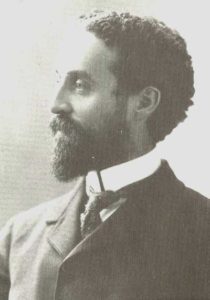
No name stands out more prominently in the history of the New Thought movement than that of the Dressers. Horatio W. Dresser, son of Julius A. and Annetta Seabury Dresser, was perhaps the most prolific writer yet developed within the movement.
Born in 1866, the year P. P. Quimby died, Horatio W. Dresser returned with his family to Massachusetts in 1882 after several years in the West. Young Horatio learned book-keeping and worked for the editor of the New England Farmer, writing shorthand and reading proof, later serving as book-keeper and business manager. Much of his life was thereafter to be linked with editing, writing, and publishing. In 1883 he took up a study of Emerson and other great writers and copied for his father the Quimby Manuscripts loaned to him by George Quimby.
In 1884, at the age of 18, he began to practice mental healing along with his parents. He had European trips in 1888 and 1889, and prepared under a private tutor for entrance into Harvard, entering as a special student in 1891. His father died in 1893 and he was out of school for a time because of his own ill health, but eventually he completed his work for the A.B. degree.
His first publication was a lecture entitled “The Immanent God” in 1894 while he was still an undergraduate. The following year saw the publication of his first full-length book, “The Power of Silence.” By 1903 that book had gone through fifteen editions. Meanwhile he had undertaken graduate work in the department of philosophy at Harvard, studying with William James, Josiah Royce, and others. He received the master’s degree in 1904 and the Ph.D., also from Harvard, in 1907. He was an assistant in the philosophy department at Harvard for several years, and enjoyed the friendship particularly of William James. It was this, in part at least, that gave Professor James his insight into the New Thought movement, which he classed among “the religions of healthy-mindedness” in his classic work “Varieties of Religious Experience.”
All during these years Dresser was writing and publishing. In 1896 he began the publication of a monthly magazine, “Journal of Practical Metaphysics,”with the avowed principle of “being helpful in the conduct of life, to prepare the way for a better, more harmonious, rational, and ethical life, and to derive this help from all the resources of human thought.” He welcomed the co-operation of all who “believe that the time has come to place the study of mind in its relation to health and happiness upon a firm scientific basis.” The magazine was published only until November, 1898, when it was merged with Arena, and Dresser became associate editor of this influential magazine.
Dresser’s volume entitled “The Power of Silence,” as already indicated, was immensely popular. Soon followed “The Perfect Whole,” and by 1897 a publisher had brought out, under the title of “The Heart of It,” major extracts from those two books, while the same year he added “In Search of a Soul.” In 1898 came “Voices of Hope;” in 1899, “Voices of Freedom and Methods and Problems of Spiritual Healing;” in 1900, “Living by the Spirit,” and “Education and the Philosophic Ideal.” At this time he was still only thirty-four years of age. Meanwhile he was turning out magazine articles and doing editorial work as well. And he found some time for active organizational work in the Boston Metaphysical Club and the International Metaphysical League.
Other titles by Dresser between 1901 and 1916 included “The Christian Ideal;” “Man and the Divine Order;” “Health and the Inner Life;” ” A Message to the Well;” “Human Efficiancy;” and in 1917 he edited “The Spirit of New Thought,” a collection of addresses and essays by major New Thought leaders, and wrote “Handbook of New Thought,” one of the simplest and most satysfying statements of the central features of the movement. Then he was invited to write “The History of the New Thought Movement,” which he did, publishing it in 1919. Two years later he laid the whole metaphysical movement deeply in his debt by publishing his very important “The Quimby Manuscripts.”
In the controversy over the matter of Mary Baker Eddy, founder of the Christian Science church, and her dependence upon Quimby, reference had been made often enough to the manuscripts, but Christian Scientists had even denied that such documents really existed. Now it was possible for anyone wondering about the relationship between Mrs. Eddy and Dr. Quimby to make their own investigation of the Portland healer’s writings and determine for themselves what the probable relationship was. Along with the manuscripts, which Dresser edited so as to eliminate much of the repetitiousness of the originals, he included certain letters from Mrs. Eddy as well as quotations from articles she had published in various New England periodicals lauding the man through whom she had been healed.
Heavy pressures upon the publishers led to the exclusion of this material from subsequent editions, but an electronic edition of the original first edition is now available for internet users to read on-line.
Horatio W. Dresser wrote two more books, “Spiritual Health and Healing,” and in 1933, when he was sixty-seven years of age, “Knowing and Helping People.” In his later years Dr. Dresser was a member of the Church of Our Saviour in Brooklyn Heights, a Unitarian Congregational church, and gave a series of evening conferences on the general topic of Health and Inner Control, and made himself available for personal conference at certain morning hours. He also led quiet hours of meditation at the church. So to the end, although no longer actively involved in the New Thought organization, he was still engaged in giving practical effect to its major interests. He died on March 30, 1954, at the age of eighty-eight.